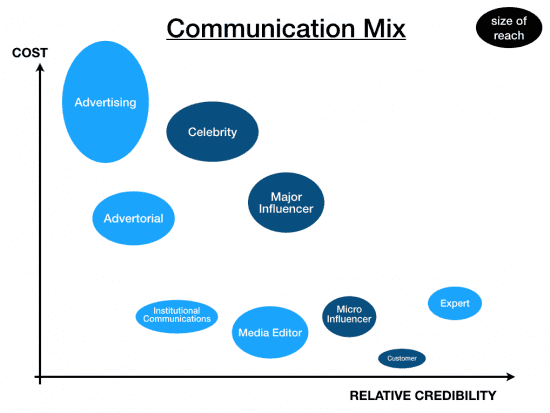From everything I hear and read, it’s fair to say that brand marketing teams — at least at major consumer-facing companies — have all now established some kind of influencer marketing strategy. With influencer marketing platforms becoming more mainstream, funds are being diverted from “traditional” marketing to influencer campaigns and, correspondingly, specific lines are being created in marketing P&Ls. How much money is thrown at influencers and how the brands go about their influencer outreach, however, varies madly.
Influencer Marketing Strategy 1.0
Using an old-fashioned approach to marketing, one might weigh up one’s options in a communication mix along two components: cost versus reach, to determine the illusive ROI. However, that view is missing an important angle, the one that, at once, is a marketer’s biggest issue and, potentially, an influencer’s biggest advantage: the credibility factor with potential customers. The short cut to mass reach will lead marketers in large brands to seek the big bubbles in the graph below in order to push their communications out. The downsides, however, are three-fold:
- overall cost
- inability to trace the conversion funnel (i.e. ROI)
- and, most treacherously, the reduced relative level of credibility and, therefore, trustworthiness
The cost of influencer marketing
A 2017 study by Rakuten Marketing (as reported by The Drum) found that the “price” of a Facebook post — with a mention of the brand — by someone with over a million followers was up to £75,000 ($100,000). Yet, the impact of such a mention and the conversion into sales is a difficult exercise, even for online pure players. For the big consumer brands, the ‘micro’ option is essentially untenable because it’s not scaleable.
The underside of influencers
The opportunity for Youtubers or Instagrammers to sit in their homes, film/photograph themselves endlessly, and develop a gaggle of followers has brought with it a lot of less dignified content and seedier practices, including the buying of fans, bots and fake accounts. If I applaud entirely Unilever CMO Keith Weed’s call to render the influencer marketing world more transparent (see The Drum article). As Weed says:
“At Unilever, we believe influencers are an important way to reach consumers and grow our brands. Their power comes from a deep, authentic and direct connection with people, but certain practices like buying followers can easily undermine these relationships.”
 However, if cleaning up the influencers is important, I think the real issue is figuring out the appropriate influencer marketing strategy for each brand. Copy/pasting the mass advertising mindset to influencer marketing is nothing shy of a complete misunderstanding, if not waste, of how influencers should be considered by brands. Engaging with influencers is anything but a mass operation. I liken the way some brands connect with influencers to the way some people try to “connect” on Linkedin. The plea essentially goes along the line: “Please connect/engage with me as I think you have an interesting network.” In other words, zero WIIFM (what’s in it for me). Moreover, it shows a laziness that suggests that follow up will be negligible if at all.
However, if cleaning up the influencers is important, I think the real issue is figuring out the appropriate influencer marketing strategy for each brand. Copy/pasting the mass advertising mindset to influencer marketing is nothing shy of a complete misunderstanding, if not waste, of how influencers should be considered by brands. Engaging with influencers is anything but a mass operation. I liken the way some brands connect with influencers to the way some people try to “connect” on Linkedin. The plea essentially goes along the line: “Please connect/engage with me as I think you have an interesting network.” In other words, zero WIIFM (what’s in it for me). Moreover, it shows a laziness that suggests that follow up will be negligible if at all.
Checklist for your influencer marketing strategy
As your brand looks to expand and/or boost its influencer marketing strategy, here is a checklist of 12 items and actions that should be established.
- Does everyone have a clear notion of what your brand stands for?
- What are the values and associated behaviours that you hold dear and which you will need from any collaborators (starting with your own team)?
- Starting with your overall brand strategy, how can an influencer marketing strategy participate in achieving the overall strategy?
- Who are you wishing to reach?
- Who has legitimate sway among your target audience?
- Are these individuals aligned with your values and behaviours? What are they asking for in return? If it’s just money, then check again on their values and audience.
- Develop a long-term strategy (programme) with periodic tactics (campaigns).
- Allocate resources that don’t assume “free.” This would include personnel and activities (especially experiences); and using an adequately robust influencer marketing platform.
- Always consider the value exchange you are proposing for the influencers and their audience.
- How will you measure and reward success?
- How you will learn, adjust and pursue your programme over time? Over what period of time?
- How and when will you sunset your programme?
Your thoughts and reactions please!












